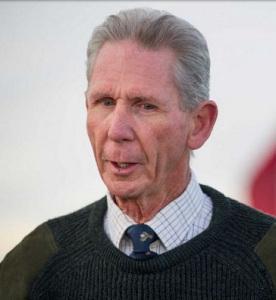Yesterday, America suffered a grievous loss when Supreme Court Justice Antonin Scalia — 79, pro-life, Christian, Constitution originalist, conservative in every sense of the word, and a towering intellect — was found dead. (See “Rest in peace, Justice Antonin Scalia“)
Scalia was a guest at the Cibolo Creek Ranch resort in West Texas, reportedly as part of a private group of about 40 people. He arrived at the resort on Friday. When he didn’t appear for breakfast Saturday, someone went to his room to check on him and found him dead.
We are told Scalia had died in his sleep on the night of February 12 or in the early morning of February 13, 2016, of natural causes — a heart attack. (New York Post)
The “someone” who found him dead has been identified.
He is John Poindexter, 71, Houston businessman and the owner of the 30,000-acre Cibolo Creek Ranch. But get this: Poindexter said he found Scalia dead, on the bed, WITH A PILLOW OVER HIS HEAD.

John Poindexter (photo by Matthew Busch/Getty Images)
Poindexter described Scalia as “animated and engaged” during dinner on Friday night: “He was seated near me and I had a chance to observe him. He was very entertaining. But about 9 p.m. he said, ‘it’s been a long day and a long week, I want to get some sleep’.” Everyone was in bed by 10 p.m.
Around 8:30 the next morning (Saturday), Poindexter went to Scalia’s room to wake him up. The room’s door was locked and Scalia did not answer. So Poindexter went for an outing with a friend of Scalia who had accompanied the Supreme Court justice from Washington.

Scalia’s “El Presidente” suite at Cibolo Creek Ranch (photo by Matthew Busch/Getty Imaages)
Three hours later, Poindexter returned and, in his words, “We discovered the judge in bed, a pillow over his head. Everything was in perfect order. He was in his pajamas, peacefully, in bed. His bed clothes were unwrinkled. He was lying very restfully. It looked like he had not quite awakened from a nap.”
Hello? Who sleeps with a pillow over one’s head???
Scalia did not have a pulse and his body was already cold. After consulting with a doctor at a hospital in Alpine, Poindexter concluded resuscitation would have been futile, He then contacted federal authorities, at first encountering a series of answering services because he was calling on a weekend: “Ultimately they became available and handled it t superbly. They flew in by helicopter. They told me to secure the ranch, which I did until this morning.”
Scalia’s body was moved to the Sunset Funeral Home in El Paso, about 3 hours away, arriving at around 2:30 a.m. Sunday morning. Spokesman Chris Lujan said the funeral home was chosen by Scalia’s family and at the advice of a family friend. The El Paso County medical examiner’s office said they hadn’t received any information regarding the possibility of performing an autopsy.

Presidio County Judge Cinderela Guevara
It took hours for authorities in remote West Texas to find a justice of the peace — Presidio County Judge Cinderela Guevara, who “pronounced Scalia dead of natural causes without seeing the body — which is permissible under Texas law — and without ordering an autopsy.”
Guevara said she had spoken to law enforcement officials at the scene, who assured her “there were no signs of foul play,” as well as Scalia’s physician in Washington, who said that Scalia had suffered from a host of chronic conditions. Guevara is awaiting a statement from Scalia’s doctor that will be added to his death certificate when it is issued later this week. Guevara also said reports that Scalia had died of a heart attack are not true, insisting that “He died of natural causes.”
A manager at the Sunset Funeral Home where Scalia’s body was taken said that his family made it clear they did not want an autopsy.
[Sources: mySA (My San Antonio); Washington Post]
Scalia had been set to rule on a number of very controversial and divisive cases before the Supreme Court, now evenly split 4-4 between conservatives and liberals:
- Abortion: Next month, SCOTUS will hear the most significant abortion case since 1992, centering on Texas, on whether states can legally impose restrictions on abortion that do not put an “undue burden” on access to the procedure.
- Obamacare: SCOTUS is expected to rule on Zubik v. Burwell, on whether Obamacare’s requirement that employers must provide female employees with no-cost access to birth control, including abortifacients, violates religious nonprofits’ religious freedom. The plaintiffs include the Roman Catholic Archdiocese of Washington and the Little Sisters of the Poor.
- Unions: Scalia was the swing vote in Friedrichs v. California Teachers Association, a case challenging the legality of “fair share” fees that unions charge nonmembers to cover costs associated with collective bargaining.
- Affirmative Action: In Fisher v. University of Texas, on the use of affirmative action and race in college admissions, Scalia had argued that affirmative action shortchanges minorities by putting them into an environment where they cannot perform as well as other students.
- Separation of church and state: In Trinity Lutheran Church of Columbia v. Pauley, on whether religious schools can continue to be denied publicly-funded grants, Scalia had argued that, if a democratic majority wants to, banning state lawmakers from funding religious schools would impede the free exercise of religion.
- Climate change: One of Scalia’s last official acts as a justice was to deliver a large dent in Obama’s climate legacy, providing one of five votes to stay the Clean Power Plan, which regulates carbon emissions from power plants.
- Immigration: In April, SCOTUS will argue a challenge to Obama’s use of executive orders to allow up to 5 million more illegals to apply for quasi-legal status and work permits.
- Gun rights: The National Rifle Association maintains that Scalia’s death puts gun rights in jeopardy because, given the ages of SCOTUS judges, the next president will have a chance at choosing four judges. The NRA plans to spend over $20 million on the upcoming election to push gun rights. “In my view, all the chips are on the table in this election because the impact is who gets the Supreme Court,” said the NRA’s chief, Allan D. Cors in an interview with Secrets this month.
[Sources: Politico; Washington Examiner]
~Eowyn

